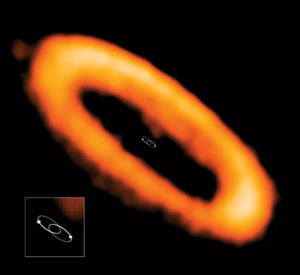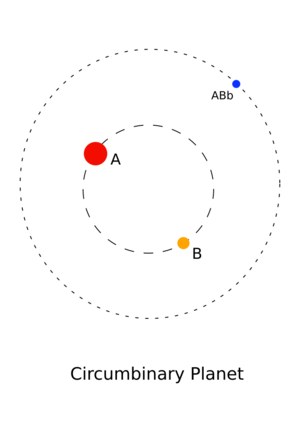Circumbinary planet facts for kids

A circumbinary planet is a planet that goes around two stars instead of just one. Imagine two stars dancing around each other; a circumbinary planet orbits both of them at the same time. It usually orbits much farther away from the center of the system than the two stars orbit each other. Scientists think that these planets and their two stars might have all formed from the same giant cloud of gas and dust.
Contents
Discovering Circumbinary Planets
Scientists have found many circumbinary planets. Here are some of the most famous discoveries:
First Confirmed Planets
PSR B1620-26
The very first circumbinary planet was found around a system called PSR B1620-26. This system has a special kind of star called a millisecond pulsar and a white dwarf star. It's located in a big group of stars called M4. Scientists first noticed something unusual in 1993. After five years of watching, they realized it was a planet! In 2003, they figured out the planet is about 2.5 times bigger than Jupiter. It orbits its two stars in a nearly circular path, about 23 AU away. (An AU is the distance from Earth to the Sun).
HD 202206
In 2005, scientists found the first circumbinary planet orbiting two "normal" stars (like our Sun). This system is called HD 202206. It has a star similar to our Sun and a brown dwarf. A brown dwarf is bigger than a planet but smaller than a star. The planet found here is about the size of Jupiter. Scientists are still studying how this system formed.
Kepler-16
On September 15, 2011, astronomers using NASA's Kepler space telescope made an exciting discovery. They found Kepler-16b, the first circumbinary planet found by watching it pass in front of its stars (this is called a "transit"). This planet is about 200 light years from Earth. It's thought to be a cold world made of rock and gas, similar in size to Saturn. It orbits two stars that are also orbiting each other. The planet takes 229 days to orbit both stars.
PH1 (Kepler-64)
In 2012, some amazing volunteers from a project called Planet Hunters helped discover PH1b. This circumbinary planet is even more special because it orbits not just two, but four stars! It's part of a quadruple star system.
Kepler-453
In 2015, scientists confirmed another circumbinary planet, Kepler-453b. It takes about 240.5 days to orbit its two stars.
Kepler-1647
A new planet, Kepler-1647b, was announced on June 13, 2016. It was also found using the Kepler telescope. This planet is a gas giant, much like Jupiter. It's the second largest circumbinary planet found so far, after PSR B1620-26. What's really cool is that it orbits its stars in the "habitable zone." This is the area where temperatures might be just right for liquid water to exist, if the planet had a surface. It takes a very long time, 1107 days, to orbit its stars.
TOI-1338 b
On January 6, 2020, scientists announced a large planet called TOI-1338 b. It's about 6.9 times bigger than Earth and is 1,300 light years away.
Other Interesting Observations

Scientists have also looked for planets around other binary star systems. Sometimes, they find big disks of dust and gas orbiting two stars. These are called "circumbinary disks." They are important because new planets are thought to form within these disks. One example is the disk around the AK Scorpii system.
How Circumbinary Systems Work
Scientists have learned a lot about how these unique systems behave:
How Common Are They?
The Kepler telescope has shown that circumbinary planets are fairly common. Out of about 1000 binary star systems it looked at, it found seven planets.
Planet Orbits
All the circumbinary planets found by Kepler tend to orbit their stars in almost the same flat plane as the two stars orbit each other. This suggests that the planets and stars likely formed together from one large, flat disk of material. However, some planets, like Kepler-413b, are slightly tilted. This tilt might be caused by the gravity of other planets or even a third star in the system.
Where Planets Orbit
There's a certain distance from a binary star system where a planet's orbit can be stable. This "safe zone" is usually about 2 to 4 times the distance between the two stars themselves. Interestingly, most of the circumbinary planets found so far orbit very close to this minimum safe distance. Scientists are still trying to figure out why this is the case.
Planet Size
Most of the confirmed circumbinary planets found by Kepler are smaller than Jupiter. This is interesting because bigger planets are usually easier to spot. This suggests that smaller planets might be more common around binary stars.
Could They Support Life?
All the circumbinary planets found by Kepler are either in or very close to the habitable zone. This is the region around stars where temperatures are just right for liquid water to exist on a planet's surface. None of these planets are rocky like Earth, but if they had large moons, those moons could potentially be habitable! However, because there are two stars, the amount of light and heat a planet receives would change a lot, unlike the steady sunlight Earth gets.
List of Circumbinary Planets
Confirmed Circumbinary Planets
| Star System | Planet | Size (MJ) |
Orbit Distance (AU) |
Orbit Time (days) |
Discovered | How it was Found |
|---|---|---|---|---|---|---|
| PSR B1620-26 | b | 2±1 | 23 | ~ 24820 | 1993 | Pulsar timing |
| HD 202206 | c | 2.179 | 2.4832 | 1397.445±19.056 | 2005 | Radial velocity |
| Gliese 900 | b | 10.47 | 12,000 | 5×108 | 2024 | Direct imaging |
| DP Leonis | b | 6.05±0.47 | 8.19±0.39 | 10220±730 | 2010 | Eclipsing binary timing |
| Kepler-16 | b | 0.333±0.016 | 0.7048±0.0011 | 228.776+0.020 −0.037 |
2011 | Transit |
| Kepler-34 | b | 0.220±0.0011 | 1.0896±0.0009 | 288.822+0.063 −0.081 |
2012 | Transit |
| Kepler-35 | b | 0.127±0.02 | 0.603±0.001 | 131.458+0.077 −0.105 |
2012 | Transit |
| Kepler-38 | b | < 0.384 | 0.4644±0.0082 | 105.595+0.053 −0.038 |
2012 | Transit |
| Kepler-47 | b | 0.027±0.005 | 0.2956±0.0047 | 49.514+0.040 −0.027 |
2012 | Transit |
| Kepler-47 | c | 0.07±0.061 | 0.989±0.016 | 303.158+0.072 −0.020 |
2012 | Transit |
| PH1 | b | < 0.532 | 0.634±0.011 | 138.506+0.107 −0.092 |
2013 | Transit |
| ROXs 42B | b | 9±3 | 140±10 | ? | 2014 | Imaging |
| HD 106906 | b | 11±2 | 650 | ? | 2014 | Imaging |
| Kepler-413 | b | 0.21+0.07 −0.07 |
0.3553+0.0020 −0.0018 |
66.262+0.024 −0.021 |
2014 | Transit |
| Kepler-453 | b | < 0.05 | 0.7903±0.0028 | 240.503±0.053 | 2014 | Transit |
| Kepler-1647 | b | 1.52±0.65 | 2.7205±0.0070 | 1107.5923±0.0227 | 2016 | Transit |
| OGLE-2007-BLG-349 | b | 0.25±0.041 | 2.59 | ? | 2016 | Microlensing |
| MXB 1658-298 | b | 23.5±3.0 | 1.6±0.1 | 760 | 2017 | Periodic delay in X-ray eclipses |
| KIC 5095269 | b | 7.70±0.08 | 0.80±0.005 | 237.7±0.1 | 2017 | Eclipsing binary timing |
| Kepler-47 | b | 0.060+0.075 −0.037 |
0.6992±0.0033 | 187.35±0.15 | 2019 | Transit |
| TOI-1338 | b | 0.0686 | 0.46 | 14.6 | 2020 | Transit |
| b Centauri | b | 10.9±1.6 | 556±17 | 2650±7170 | 2021 | Direct imaging |
Unconfirmed or Doubtful Planets
Sometimes, scientists think they've found a planet, but later studies show it might not be there. For example, a planet around MACHO-1997-BLG-41 was thought to exist but was later disproven. Also, some planets claimed around systems like NN Serpentis and NY Virginis are still being debated. The way these stars behave might be caused by something other than planets.
Circumbinary Planets in Stories
Circumbinary planets are popular in many science fiction stories!
- In David Lindsay's A Voyage to Arcturus, the planet Tormance orbits the binary stars Branchspell and Alppain.
- The planet in the Trigun series orbits two stars.
- In the famous Star Wars series, the desert planet Tatooine orbits a close pair of stars.
- The TV show Doctor Who has featured planets in binary systems, like in "The Chase" and possibly Gallifrey in "Gridlock".
- In the Star Fox series, planets orbit the stars Lylat and Solar.
- In The Hitchhiker's Guide to the Galaxy, the planet Magrathea is described as orbiting two stars.
- Stanislaw Lem's novel Solaris features a planet orbiting a red and a blue star.
See also
- List of planet types
- Circumtriple planet


